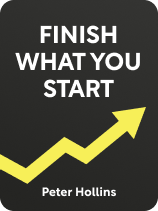

This article is an excerpt from the Shortform book guide to "Finish What You Start" by Peter Hollins. Shortform has the world's best summaries and analyses of books you should be reading.
Like this article? Sign up for a free trial here.
Do you have a productivity mindset? What motivates you to achieve your goals?
In Finish What You Start, Peter Hollins shares four ways to develop a finisher’s mindset. He explains that your mental habits shape your approach to life’s challenges and your ability to accomplish your objectives.
Keep reading to discover Hollins’s practical tips for fostering a productivity mindset and following through.
Developing a Productivity Mindset
According to Hollins, if you want to commit to finishing your life goals, you need to develop a productivity mindset. He defines “mindset” as the mental habits you use to make sense of your life experiences. Your mindset determines your attitude toward the problems in your life. Thus, without the right mindset, you’ll never work up the motivation to solve your problems and achieve your goals.
(Shortform note: In Mindset, Carol Dweck agrees that to be successful, you need the right mindset about the problems in your life. In particular, she argues that the direction of your life primarily depends on whether you have a growth mindset or a fixed mindset. People with a growth mindset believe that their abilities can be developed through dedication and hard work. In contrast, people with a fixed mindset believe that qualities like intelligence and talent are inborn traits that can’t be changed much. They want to avoid looking incompetent or deficient, so they tend to avoid challenges—missing out on the opportunities they need to learn, grow, and (eventually) succeed.)
We’ll provide several of Hollins’s tips for developing a productivity mindset.
Tip #1: Identify Your Sources of Intrinsic Motivation
First, Hollins suggests precisely identifying what motivates you. There are two kinds of motivation: extrinsic and intrinsic. Extrinsic motivation is rooted in external rewards and punishments. For instance, if you want to earn a large holiday bonus or avoid disappointing your co-workers, you’re being driven by extrinsic motivation.
In contrast, sources of intrinsic motivation only exist inside you. If you believe that something you’re doing is morally right, worthwhile, or enjoyable, that would be intrinsic motivation.
Although Hollins asserts that both forms of motivation are useful, he argues that intrinsic motivators are typically more powerful than extrinsic motivators in the long run. To this end, identifying your existing sources of intrinsic motivation allows you to consciously focus your attention on them. This focus strengthens your dedication and helps you make progress more easily.
To identify your intrinsic motivators, Hollins recommends asking self-reflective questions. Ask yourself what positive emotions you expect to feel after you attain success, how your life will be different, and how your accomplishments will help the people you care about. All of the things you’re eager to gain by achieving your goals are your intrinsic motivators. For instance, if you want to start a community food bank, your intrinsic motivators might be the idea of improving the lives of people in need and the feelings of pride that come with this.
| The Four Sources of Motivation Like Hollins, Brendon Burchard in High Performance Habits distinguishes between sources of motivation based on whether they originate from outside or inside of you. However, he narrows down all sources of motivation into four possible motivators. According to Burchard, there are two kinds of extrinsic motivation: • Duty—feelings of obligation to others • Urgency—the pressure to avoid impending negative consequences And there are two kinds of intrinsic motivation: • Identity—the need to build self-esteem by holding yourself to high standards of performance • Obsession—the need to fully understand and master a particular subject through intensive study and practice Unlike Hollins, Burchard doesn’t specify whether intrinsic motivation is more powerful than extrinsic motivation. Rather, he argues that high performers should do everything they can to boost all four sources of motivation. To this end, Burchard recommends engaging in intensive self-reflection about all sources of your motivation, not just the intrinsic ones (as Hollins suggests). Furthermore, when you ask self-reflective questions, don’t just think about your answers—Burchard contends that affirming your motivations out loud will strengthen their power. For instance, after you answer Hollins’s questions, you might say to yourself, “Once I earn my medical degree, I’ll feel proud to be such a valuable member of society. I’ll be able to spend every day doing the fulfilling work of saving people’s lives, and I’ll support my family with a substantial income.” |
Tip #2: Avoid Rumination
Hollins recommends that you develop the habit of acting before you think you’re ready instead of ruminating. Ruminating is when you spend too much time weighing the possible future consequences of your decisions. As a result, you’ll probably fail to make substantial progress toward your goals.
According to Hollins, one likely reason you ruminate (and procrastinate in other ways) is because you’re afraid of failing to achieve your goals and being judged negatively by others. To avoid failure and rejection, you obsess over doing everything you can to ensure a perfect outcome. However, since it’s impossible to ensure a perfect outcome, this mindset causes you to endlessly plan and overanalyze, never feeling fully prepared to take action.
Worrying about the future diverts your attention from the present moment, which makes it more difficult for you to take action and make decisions that lead you toward your goals. Hollins recommends doing everything you can to focus on acting responsibly in the present moment. What you do right now determines whether you’ll succeed—ruminating isn’t likely to help you much.
To avoid rumination when making decisions, Hollins suggests identifying and focusing exclusively on the most significant determining factors. Then, deliberately ignore everything else. This way, you can minimize the time you spend thinking while still making well-informed decisions. For example, if you’re trying to decide whether to accept a job offer, identify the factors that had the greatest impact on your satisfaction in your last job (perhaps flexible scheduling and autonomy at work). Then, judge the new job solely on those criteria.
(Shortform note: In Algorithms to Live By, Brian Christian and Tom Griffiths also recommend basing your decisions on the most significant factors and ignoring everything else. They argue that this strategy not only helps you avoid rumination but also results in better decisions. This is because when you take too much information into account, you’re likely to overfocus on factors that don’t matter. For instance, imagine you’re purchasing a car. You survey the options available and quickly discover which cars are the most mechanically reliable. But you don’t stop there: You research details about the available cars—details that don’t matter as much in the long run. Thus, you end up picking a car with a sound system and attractive interior that falls apart after six months.)
| Resolve the Roots of Rumination Arguably, Hollins’s advice to try your best to focus on the present isn’t enough to help people caught in the bad habit of chronic overthinking. In Stop Overthinking, Nick Trenton gives a more detailed explanation of how to identify the root of your overthinking and resolve it. First, identify the specific triggers and distorted beliefs that prompt you to ruminate. While Hollins contends that rumination is typically caused by fears of failure or rejection, Trenton asserts that a wider range of anxiety-provoking triggers can cause rumination, such as stimuli you associate with past trauma. Additionally, the habit of rumination is perpetuated by distorted beliefs about yourself and the world. For instance, you may subconsciously believe that failing to earn a promotion means that you’re worth less as a person, causing you to ruminate endlessly on how to get promoted. To identify your triggers and distorted beliefs, journal about recent situations that stressed you out, how you reacted, and how they made you feel. Once you know what triggers your rumination, you can avoid these situations (and if you can’t, try to make peace with them). Then, challenge your distorted beliefs by rationally gathering evidence to disprove them. To return to our example: If you’re ruminating about getting a promotion, you could rationally consider that some of the people in lower positions than you seem happy. |
Tip #3: Set Reasonable Expectations
Hollins warns against overestimating how easy it’ll be to achieve your goals. If you have overly optimistic expectations, you’ll only be disappointed when you don’t achieve your goals straight away. This disappointment can be very demotivating, making you less likely to persevere in the future.
Similarly, Hollins cautions against overestimating how happy achieving your goals will make you. If you expect that working hard and getting something you want will completely transform your life, you may be disappointed and demotivated if that’s not the case.
To avoid feeling disappointed and demotivated, manage your expectations: Set realistic progress goals so you can reliably complete them and feel satisfied. Likewise, don’t assume that accomplishing a single goal will resolve all the problems in your life that are making you unhappy.
| Continually Adjust Your Expectations and Pursue Balanced Goals In First Things First, Stephen R. Covey also warns that you’ll feel demotivated if you fail to accomplish a goal as easily as you expect to. He notes that this often happens if you set goals that are too ambitious. Additionally, sometimes goals that used to be reasonable for you become unrealistic after circumstances change. For instance, if a successful attorney starts experiencing excruciating migraines, they need to understand that they may no longer be able to put in productive 70-hour weeks at work. To avoid losing self-confidence, you may need to re-evaluate what qualifies as a reasonable goal that you can be proud of accomplishing. Covey also acknowledges the risk that you’ll feel demotivated after you accomplish a goal that ends up being less gratifying than you expected. He says this typically happens when you focus too intently on an ambitious goal at the expense of something else important to you. To counter this risk, he recommends strategically choosing goals that bring balance to your life. For example, if you’re pursuing the goal of starting a successful business, set another goal to organize two date nights a week with your significant other. This way, even if the business doesn’t make you feel totally fulfilled, you can be proud you invested in a healthy relationship. |
Tip #4: See Failures as Learning Opportunities
Finally, Hollins recommends viewing your life journey as a never-ending process of incremental growth. As you complete tasks and achieve your goals, you can assess what parts of your strategy and mindset work well (and which don’t), and you can identify areas for improvement. Note that the optimal conditions and strategies for success are different for everybody. The goal is to discover the conditions and strategies that best suit your unique strengths.
According to Hollins, every time you fail, it’s a sign to reexamine your working conditions, strategies, and mindset to discover why you failed. The cause may be anything from a suboptimal work schedule to negative emotions that pressure you into giving up. By repeatedly identifying and resolving the problems that cause you to fail, your chances of success will continually improve.
Additionally, when you use failures as valuable learning opportunities, you’ll come to see them as a good thing. Then, you won’t be as afraid of failing, making it easier to motivate yourself to take action.
| Learn to Crave Failure In Hidden Potential, Adam Grant argues that you should strive to not only become comfortable with failure, but find it satisfying in itself. Like Hollins, Grant says that learning from failure is the key to growth, and if you fail a lot, your fear will diminish. However, he goes on to explain that over time, as you repeatedly make mistakes and learn from them, you’ll start to associate the feeling of effort with the satisfaction of progress. After your brain makes this connection, you’ll come to enjoy the pain of failure—a characteristic called learned industriousness. This will motivate you to persevere when tasks are challenging or uncomfortable. Additionally, Grant argues that because you learn the most from failures, you can optimize your growth by intentionally practicing in a way that forces you to make mistakes. For example, if you’re learning how to draw and feel embarrassed because the faces and hands you draw always look bad, challenge yourself by drawing more faces and hands. Finally, Grant (like Hollins) acknowledges that the most productive action looks different for each unique individual. For this reason, if you’re looking to accelerate your growth, he recommends that you gather advice from multiple experts, then experiment until you discover which of their tips work for you. |
Exercise: Apply the Finisher’s Mindset to Your Life
Hollins recommends developing specific attitudes and mental habits to make it easier to sustain your motivation and follow through on your goals. See how adopting this mindset feels by applying it to your life.
- What are your most important life goals? Identify the sources of your intrinsic motivation: What do you think you’ll gain by accomplishing these goals?
- What tangible reminders could you create to keep your intrinsic motivators at the forefront of your mind? Where could you keep them to ensure you encounter them frequently?
- Reflect on a time when you ruminated excessively about a decision or task instead of taking action. How did this rumination make you feel, and what did you end up doing afterward? What could you have done differently?
- Think about what you expect to gain after achieving your major life goals. Are your expectations realistic? Why or why not? If they’re not, how might you reframe your expectations to be more realistic, yet still motivating?
- Think about a recent failure or setback you experienced while working toward a goal. What lessons can you learn from this experience? How can you adjust your approach or mindset moving forward?

———End of Preview———
Like what you just read? Read the rest of the world's best book summary and analysis of Peter Hollins's "Finish What You Start" at Shortform.
Here's what you'll find in our full Finish What You Start summary:
- How to finish that ambitious project you’re putting off
- The type of mindset that will keep you motivated
- How your environment is distracting you from important things






